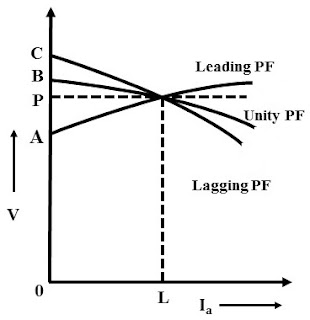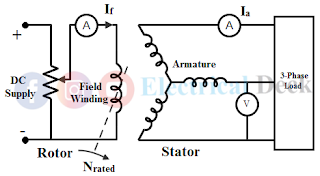When an alternator is loaded the armature terminal voltage will be less than the emf induced in the armature. This is because due to the effect of armature reaction there will be a drop in induced emf.
Suppose if the load is disconnected (open-circuited) armature current becomes zero, hence no armature flux and armature reaction effect. Therefore the terminal voltage will be equal to induced emf at no-load conditions.
The voltage regulation of an alternator or synchronous generator is defined as the changes in terminal voltage on the application of load at a constant driving speed and field excitation. It is expressed in per-unit or percentage of variation in armature terminal voltage from no-load to full-load divided by the rated terminal voltage.
Where,- Eo = No-load induced emf
- V = Rated terminal voltage
The variation in terminal voltage also depends upon the magnitude and power factor of the load. If the load connected is inductive or resistive type. For lagging and unity power factor conditions the effect of armature reaction i.e., the effect of armature flux on main flux will be demagnetizing and cross-magnetsing effects respectively.
This makes the terminal voltage drop hence regulation will be always positive. In the case of capacitive loads (leading p.f.), the effect of armature reaction will be a magnetizing effect i.e., armature flux add up with main flux. This causes to increase in terminal voltage as the load current increases and the regulation becomes negative.
The above diagram shows the relationship between load current Ia and terminal voltage V at different power factor loads. Let OP be the terminal voltage at the rated load OL.
At constant speed and field excitation, OB and OC are the change in the terminal voltage (i.e., positive) at unity and lagging p.f. respectively. Similarly for leading p.f. OA will be the change in the terminal voltage (i.e., negative). From the above diagram, the per-unit regulation is given as,
Determination of Regulation :
There are several methods of determining the voltage regulation of an alternator. They are,- Direct Loading Method.
- Indirect Methods.
Direct Loading Method :
The direct loading method is well suited for small rating alternators without actual loading. The below shows the connection diagram of the alternator to which three-phase load is connected across the armature terminals.
The field excitation is adjusted until the voltmeter across the armature terminal reads the rated voltage. Now the load is connected and increased until the ammeter reads the rated current i.e., full-load armature current.
When the load is connected the terminal voltage decreases due to armature reaction effect. Again by increasing the field excitation, the voltage V is adjusted to its rated value.
Now keeping the same speed and field excitation the entire load is disconnected from the armature terminals. Thus the load current becomes zero and the voltmeter reads the value of induced emf Eo i.e., no-load terminal voltage without armature reaction drop. Once Eo is obtained regulation is determined.
Indirect Methods of Voltage Regulation :
Alternators at the power plants are of large rating as 500MVA. It is difficult to determine voltage regulation for such high capacity alternators using direct loading at the laboratory. It is therefore to perform indirect methods by indirectly simulating the load conditions which consumes less power. The various indirect methods of determining voltage regulation are,





